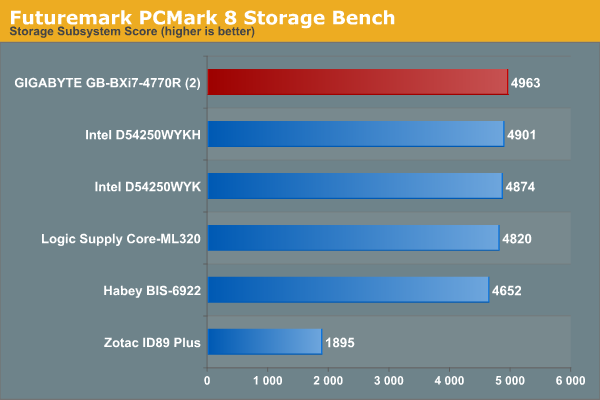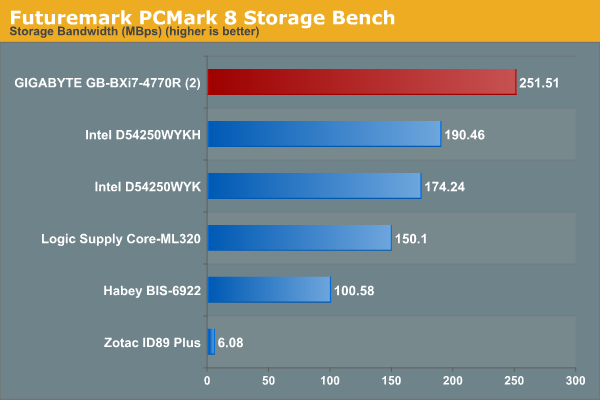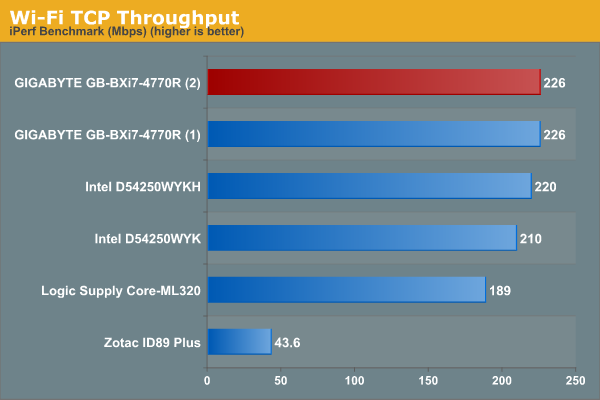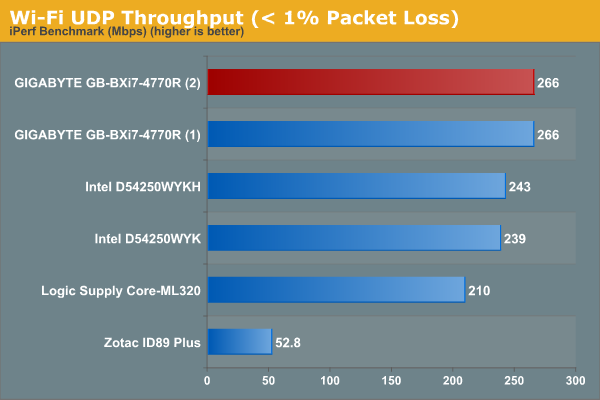GIGABYTE BRIX Pro: A Second Look at the Intel i7-4770R with Iris Pro HD 5200
by Ganesh T S on June 14, 2014 5:00 PM ESTNetworking & Storage Performance
We have recently started devoting a separate section to analyze the storage and networking credentials of the units under review. On the storage side, one option would be repetition of our strenuous SSD review tests on the drive(s) in the PC. Fortunately, to avoid that overkill, PCMark 8 has a storage bench where certain common workloads such as loading games and document processing are replayed on the target drive. Results are presented in two forms, one being a benchmark number and the other, a bandwidth figure. We ran the PCMark 8 storage bench on selected PCs and the results are presented below. Note that this is not a reflection of the performance of the BRIX Pro by itself, but more of a validation of our choice of the storage drive for the build.


On the networking side, we restricted ourselves to the evaluation of the WLAN component. Our standard test router is the Netgear R7000 Nighthawk configured with both 2.4 GHz and 5 GHz networks. The router is placed approximately 20 ft. away, separated by a drywall (as in a typical US building). A wired client (Zotac ID89-Plus) is connected to the R7000 and serves as one endpoint for iPerf evaluation. The PC under test is made to connect to either the 5 GHz (preferred) or 2.4 GHz SSID and iPerf tests are conducted for both TCP and UDP transfers. It is ensured that the PC under test is the only wireless client for the Netgear R7000. We evaluate total throughput for up to 32 simultaneous TCP connections using iPerf and present the highest number in the graph below.

In the UDP case, we try to transfer data at the highest rate possible for which we get less than 1% packet loss.

The Realtek 802.11ac module, despite being only 1T1R, surprisingly fares better than the Intel one (2T2R) when used with the Broadcom-based Netgear R7000 router.










55 Comments
View All Comments
basroil - Sunday, June 15, 2014 - link
Lets put some kinect fusion data in there, this computer is basically begging to be put on a robot!TomWomack - Sunday, June 15, 2014 - link
Do you know of any company planning to release an i7/4770R on a board which can be put into a reasonably-cooled box, rather than in a size-optimised cooling-constrained one?Qwertilot - Sunday, June 15, 2014 - link
No idea. It does sound a bit like Broadwell K should basically do that when it rolls around though.(While presumably performing better too.).
duploxxx - Monday, June 16, 2014 - link
Would really be interested in putting some AMD based solutions next to that, for sure on the very high price of that box.Secondly you clearly see that high res is impossible to play on iris due to the low eDRAM size. so you can say that AMD APU parts really need high speed memory, but you know that the iris pro will never make it for high res even with better memory. so it fails in delivering future.
duploxxx - Monday, June 16, 2014 - link
if you combine a few reviews and look at the Kaveri launch then the 4770R with edram intel part delivers the gpu performance of the same A8-7600 at the same 65W package but probably 3x more expensive... so you don't need to buy this box for gaming, you are better of with the AMD part.JBVertexx - Monday, June 16, 2014 - link
Would like to have seen benchmarks vs. an A10-7850k based build.Hrel - Monday, June 16, 2014 - link
Considering you can make a good gaming rig with a AMD R7 265 for $500 it makes no sense at all to buy a system with an Intel IGP for anything more than $500. Yes, with the Brix platform you get something nicely compact, which is why it's worth the SAME as a good gaming rig that's larger. But it's certainly not worth MORE!isa - Monday, June 16, 2014 - link
First, I LOVE the comparative PC config table with pulldown selection - very effective and efficient comparison method.Second, I think mini-ITX PCs look really, really interesting with a Broadwell CPU (fewer heat issues) and m.2 pcie x4 slot (smaller, better air flow, better overall perf). If the writer has any influence with makers of such PCs and you agree, it would be great if such PCs retained the 2.5in drive slot when m.2 is added. Such a PC gets pretty close to ideal for many uses.
Lastly, I agree (if I understood it correctly) that increasing the case height is just fine if needed - keep the footprint the same but going higher would work well in anything I need.
isa - Monday, June 16, 2014 - link
Ooops: I screwed up: these PCs aren;t mini-ITX, since these motherboards are about 4"x4", and mini-ITX is about 6.7"x6.7". But I can't find anything on what to call this motherboard form factor other than "NUC-like". Anyone have a better term for these motherboard form factors?Redstorm - Monday, June 16, 2014 - link
No mention of the broken de-interlacing on the iGPU under linux. Intels devs cant even get it working in the driver. If you want to use one as a HTPC under linux and XBMC your stuck with software de-interlacing as the iGPU is borked.